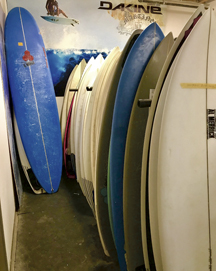Surfing….Soft Tops?

Few people know that the invention of soft tops was an instinctive reaction to the Black Ball rules on beaches in Southern California in the early 1960’s. The ‘Rules’ refer to lifeguards communicating to surfers on fiberglass boards that they have to exit the ocean, via a yellow flag with a black ball in the center. Like current days in Ditch during the summer, the risk of injury is high with increasing crowds in the water. The potential carnage factor is greater on busier days, surfers colliding with each other and with swimmers nearby are risks to avoid.
As surfers love to do, they looked for ways around the rules and developed ‘Black Ball Beater’ boards to stay in the line-up. Finless and soft, these boards evolved into what we now refer to as the soft top.
 Ideal for beginners, those learning, or extra guests at your beach house for the summer that want to dabble in surfing on the weekends, the soft top is your solution. They also suit the noncommittal type that may want to sample different shapes and sizes before committing to a fiberglass board purchase.
Ideal for beginners, those learning, or extra guests at your beach house for the summer that want to dabble in surfing on the weekends, the soft top is your solution. They also suit the noncommittal type that may want to sample different shapes and sizes before committing to a fiberglass board purchase.
As for performance, soft tops are more modern and often designed by professional shapers with the goal of catching as many waves as possible. The Pros? They are great for travel, throwing them in the back of your car, free from worry about dings or repair. They are much safer if you’re hit or hit someone and they are super durable. You’re less like to damage another person’s board which will save you money and possibly improve your personal safety (depending on the local). They have a high resell value since boards will appear like new when you’re ready to move on to your next board. And no wax needed! The cons include things like greater weight than a fiberglass board, and getting complacent following rules in the water since hey, it’s just a soft top. They could also cause a rash if you’re not wearing a rash guard.
If you’re willing to give them a chance, check out the soft tops from Channel Islands. For almost fifty years, CI has been about advancing the highest performance surfing possible. Team rider Bethany Hamilton collaborated with Channel Islands on a line of soft top boards that are fun and accessible for every level of surfer.
And just like fiberglass boards, soft tops require care to stay in good shape. Rinse your board with fresh water like the rest of your gear when you’re done with your session so it doesn’t become brittle. Air dry it out of direct sunlight so the UV rays don’t damage the laminated and glued parts over time. Transport and store your board safely as you would a fiberglass board to avoid any unnecessary dents or careless accidents that will cause breakage. Since soft tops have evolved into a reasonable option on a given day in the lineup, this might be the summer to give one a try. And if a new Black Ball flag emerges it’s likely a new surf board invention will, too.

